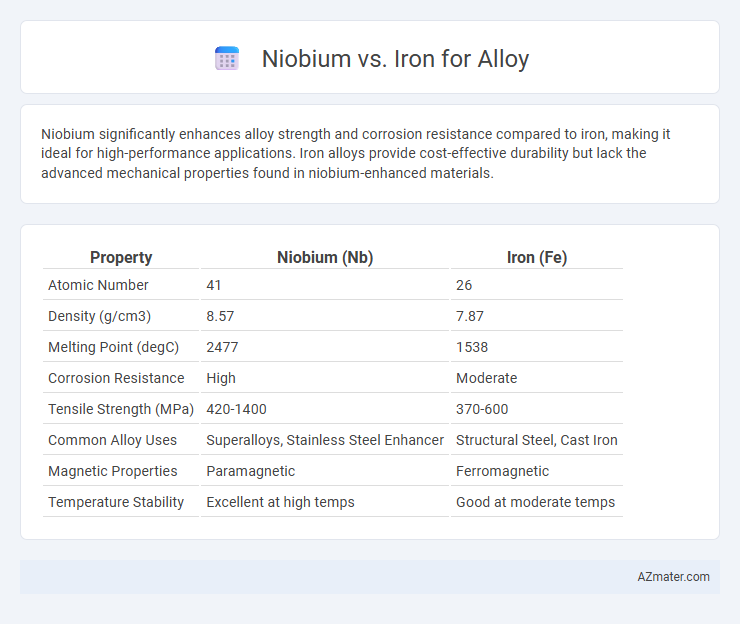Niobium significantly enhances alloy strength and corrosion resistance compared to iron, making it ideal for high-performance applications. Iron alloys provide cost-effective durability but lack the advanced mechanical properties found in niobium-enhanced materials.
Table of Comparison
| Property | Niobium (Nb) | Iron (Fe) |
|---|---|---|
| Atomic Number | 41 | 26 |
| Density (g/cm3) | 8.57 | 7.87 |
| Melting Point (degC) | 2477 | 1538 |
| Corrosion Resistance | High | Moderate |
| Tensile Strength (MPa) | 420-1400 | 370-600 |
| Common Alloy Uses | Superalloys, Stainless Steel Enhancer | Structural Steel, Cast Iron |
| Magnetic Properties | Paramagnetic | Ferromagnetic |
| Temperature Stability | Excellent at high temps | Good at moderate temps |
Introduction to Niobium and Iron in Alloy Production
Niobium is a critical alloying element known for enhancing strength, toughness, and corrosion resistance in steel production, especially in high-strength low-alloy (HSLA) steels. Iron serves as the principal base metal in alloy manufacturing, providing a versatile and cost-effective matrix to which elements like niobium are added to tailor mechanical properties. The combination of iron and niobium in alloys results in advanced materials with superior performance in automotive, construction, and pipeline industries.
Atomic Structure: Niobium vs Iron
Niobium has an atomic number of 41 with an electron configuration of [Kr] 4d4 5s1, which provides a body-centered cubic (BCC) crystal structure that enhances its strength and corrosion resistance in alloys. Iron, with an atomic number of 26 and electron configuration [Ar] 3d6 4s2, also exhibits a BCC structure at room temperature but transitions to a face-centered cubic (FCC) structure at higher temperatures, affecting its ductility and magnetic properties. The difference in d-electron count and atomic radius between niobium and iron influences their bonding characteristics, impacting the mechanical and thermal performance of niobium-iron alloys.
Mechanical Properties Comparison
Niobium significantly enhances the mechanical properties of iron-based alloys by improving strength, toughness, and corrosion resistance through the formation of stable carbides and nitrides. Alloys containing niobium exhibit higher tensile strength and better fatigue resistance compared to pure iron or conventional iron alloys, making them ideal for high-stress applications such as aerospace and construction. The grain refinement effect of niobium also contributes to improved ductility and fracture toughness, outperforming standard iron alloys in demanding mechanical environments.
Corrosion Resistance: A Comparative Analysis
Niobium significantly enhances corrosion resistance in alloys compared to iron by forming stable passive oxide layers that prevent oxidation and degradation in harsh environments. Iron-based alloys are prone to rust and corrosion unless alloyed with protective elements, whereas niobium contributes to improved chemical inertness and durability, especially in acidic and high-temperature conditions. This makes niobium-containing alloys particularly valuable in aerospace, chemical processing, and marine applications where long-term resistance to corrosion is crucial.
Heat Resistance and Thermal Stability
Niobium significantly enhances heat resistance and thermal stability in alloys compared to iron, due to its high melting point of 2,468degC and superior ability to maintain strength at elevated temperatures. Alloys containing niobium exhibit improved creep resistance and oxidation stability, making them ideal for high-temperature applications such as aerospace and power generation. In contrast, iron-based alloys have lower thermal stability, with melting points around 1,538degC, limiting their performance under extreme heat conditions.
Alloying Effects: Strength and Ductility
Niobium significantly enhances alloy strength by promoting fine grain refinement and precipitation hardening in steel, resulting in improved tensile strength and yield strength compared to iron-based alloys without niobium. The addition of niobium also increases ductility, enabling alloys to absorb more deformation before failure, whereas pure iron alloys tend to have lower strength and ductility balance. Niobium's effect in alloying contributes to superior mechanical properties, especially in structural applications requiring high strength-to-weight ratios and resilience.
Industrial Applications of Niobium-Alloyed Steel
Niobium-alloyed steel enhances strength, corrosion resistance, and weldability, making it ideal for industrial applications such as pipelines, automotive components, and structural beams. Niobium's microalloying effect refines grain structure, improving toughness and fatigue resistance compared to iron-based alloys. These properties extend service life and reduce maintenance costs in demanding environments like oil and gas and construction industries.
Cost and Availability of Niobium vs Iron
Niobium is significantly costlier than iron due to its rarity and complex extraction process, with prices typically ranging from $40 to $50 per kilogram compared to iron's few cents per kilogram. While iron is abundantly available worldwide and easily sourced for large-scale alloy production, niobium reserves are concentrated primarily in Brazil and Canada, limiting accessibility and increasing import costs. These economic factors make iron more favorable for cost-sensitive applications, whereas niobium is reserved for specialized alloys requiring enhanced strength and corrosion resistance.
Environmental Impact and Sustainability
Niobium enhances steel alloys by increasing strength and durability, allowing for material reduction and lower carbon emissions during production compared to traditional iron alloys. The use of niobium in high-strength low-alloy steel contributes to energy efficiency and extends the lifespan of infrastructure, supporting sustainability goals. Iron mining and processing generally result in higher environmental footprints due to greater energy consumption and greenhouse gas emissions relative to niobium-enhanced alloys.
Future Trends in Alloy Development
Niobium enhances alloy strength and corrosion resistance, making it a critical element for next-generation high-performance steels in aerospace and automotive industries. Iron-based alloys doped with niobium show promising improvements in thermal stability and fatigue resistance, aligning with future demands for lightweight, durable materials. Advances in nanostructured niobium-iron alloys focus on optimizing mechanical properties while reducing environmental impact in alloy production.

Infographic: Niobium vs Iron for Alloy
 azmater.com
azmater.com